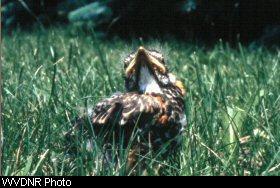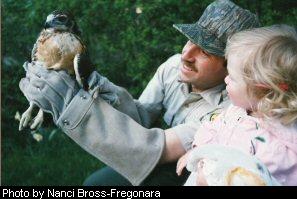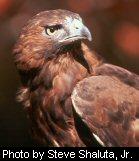

Want to Lend a Helping Hand? Think Twice!By Jim Fregonara
In the majority of cases, there was nothing wrong with a young bird like this. It was old enough to leave its nest, but still too young to fly. All birds go through this phase before they become adults. Although the parents weren't visible, they were probably nearby, still caring and feeding it along with their other fledglings. So the best thing to do is leave it alone. Mother Nature sometimes seems cruel, but the fact remains that the majority of birds born this year will not survive past one year. Weather, predation , starvation and disease are all components of the environment that influences an animal's survival. A predator which raids a bird nest is only doing what it instinctively does to ensure its own survival. A few days of cold rain can also kill young birds because their feathers are not completely formed and therefore the young are extremely susceptible to the cold. A female lays as many eggs as she can care for to offset chick mortality. Some nests will completely fail one year, but be more successful the next. If you find a very young bird that you are certain just fell out of its nest, the best thing you can do is quickly place the bird back in its nest and the parents will continue to feed it. Despite the misconception that a baby bird will be abandoned if touched by humans, most birds have a poor sense of smell and will not detect a human's scent.
If you are contemplating “adopting” a baby bird, consider this. Caring for these birds requires an enormous amount of work. If you have ever watched robins feed their newborn you'll soon realize that they are constantly returning to their nest with a mouthful of food for their young. If young birds are fed by humans, this translates to feeding them every 20 minutes, all day long. This obviously requires a great deal of effort and only the parents know the best food for their young. Young birds in captivity fed bread or other human food will starve to death. Dry dog or cat food dipped in egg is the recommended substitute.
In many instances the food given to young birds is totally different from what they will eat when they are mature. The cedar waxwing, found throughout the Mountain State, is a good example. As an adult, its main food source is berries. But as a nestling, the parents feed it insects, which are higher in protein than fruit and important for their quickly developing bodies. Also, you must take care of the bird's droppings. The young are constantly creating waste products that must be removed from the nest. In the wild, an adult will remove the droppings in the form of a fecal sac and dispose of it a safe distance away from the nest to deter predators from smelling and detecting the nest. Another reason not to attempt to raise young birds is that human intervention can decrease their survival. In most birds, there is a short period of time when it is very sensitive to its caretaker. During this time a bird can imprint on a human and think the person is one of its parents. A young bird needs to observe its natural parents hunting for prey or it will have to try to learn this survival technique on its own. A wild bird should never be placed in a wire cage with a bowl of water. Confined birds will be in a state of shock and try to escape any enclosed area. Not only can they get their feathers tangled in the sides of the cage creating more injury, they can tip the water container, soaking themselves in the process. It is better to use a cardboard box, which also provides some calming privacy. Warmth is another important requirement for a young bird's survival because the insulating capabilities of its feathers are not fully developed. If a bird is kept in captivity, a heating pad set on low can be used under half of the box. This way a heat gradient will be created and the bird can chose the best location in the box. Place the pad under the outside of the box to avoid any chance of electric shock. If these reasons aren't enough to deter you from trying to raise young birds, remember it is also against the law to have a wild bird in your possession, dead or alive. Even the most well-intentioned person could still be in violation of state and federal laws. So the next time you are fortunate enough to observe young wildlife and are tempted to take an animal home, the best thing you can do for both you and the young one is to leave it alone. Jim Fregonara is a wildlife biologist stationed in Elkins .
|
 You are taking a leisurely spring walk with your children when suddenly a baby bird flutters to the ground, flapping its wings furiously, but unable to fly. Thinking this newborn bird is injured and in danger, you do what most people do – catch it and bring it home to care for. You place it in an old wire cage, and give it a bowl of water and some breadcrumbs. The next day you awaken only to find a wet, dead bird lying in the corner of the cage. You tried to do everything right, but the truth is, you did everything wrong.
You are taking a leisurely spring walk with your children when suddenly a baby bird flutters to the ground, flapping its wings furiously, but unable to fly. Thinking this newborn bird is injured and in danger, you do what most people do – catch it and bring it home to care for. You place it in an old wire cage, and give it a bowl of water and some breadcrumbs. The next day you awaken only to find a wet, dead bird lying in the corner of the cage. You tried to do everything right, but the truth is, you did everything wrong.  But use common sense when deciding to return the nestling. Is it worth climbing high up into a tree risking injury? If the nest is too far out of reach, find a strawberry basket or small cardboard box with an open top, fill it with soft shredded cloth, place the bird in the basket and hang it from a tree branch as close to the nest as possible. The adults should continue to feed and care for their young. Make sure the basket is suspended high enough so that it is out of the reach of cats and curious children.
But use common sense when deciding to return the nestling. Is it worth climbing high up into a tree risking injury? If the nest is too far out of reach, find a strawberry basket or small cardboard box with an open top, fill it with soft shredded cloth, place the bird in the basket and hang it from a tree branch as close to the nest as possible. The adults should continue to feed and care for their young. Make sure the basket is suspended high enough so that it is out of the reach of cats and curious children.  Rescuing an injured raptor can be risky business and could result in severe injury to the person handling the bird. A raptor has extremely sharp talons which can easily penetrate any unprotected arm and a sharp beak designed for tearing flesh. If you must catch an injured raptor, the best way is to slowly approach it from behind and throw a blanket or jacket over it to calm it down. Make sure you are wearing heavy leather gloves and grab the bird's legs from behind, above the talons. Make sure to grab both feet at the same time. If only one foot is grabbed, it will quickly use its free talons to grab whatever is close, such as your arm. Make sure your face is far from striking distance of its powerful beak. Remember, the bird thinks you are a predator and may be fighting for its life.
Rescuing an injured raptor can be risky business and could result in severe injury to the person handling the bird. A raptor has extremely sharp talons which can easily penetrate any unprotected arm and a sharp beak designed for tearing flesh. If you must catch an injured raptor, the best way is to slowly approach it from behind and throw a blanket or jacket over it to calm it down. Make sure you are wearing heavy leather gloves and grab the bird's legs from behind, above the talons. Make sure to grab both feet at the same time. If only one foot is grabbed, it will quickly use its free talons to grab whatever is close, such as your arm. Make sure your face is far from striking distance of its powerful beak. Remember, the bird thinks you are a predator and may be fighting for its life.